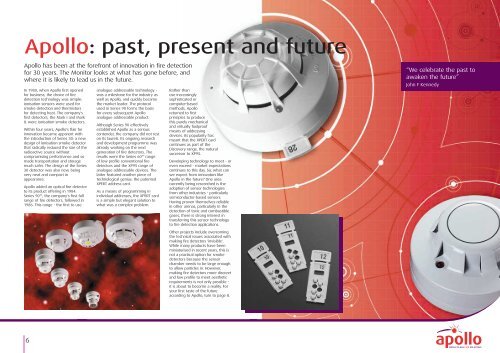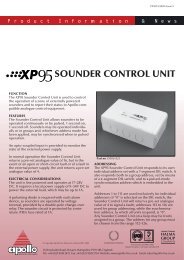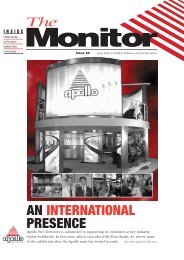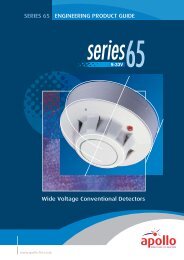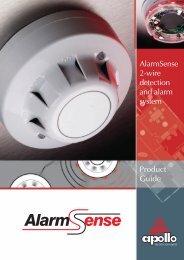Monitor 43 V1 (Page 1 - 2) - Apollo Fire Detectors Limited
Monitor 43 V1 (Page 1 - 2) - Apollo Fire Detectors Limited
Monitor 43 V1 (Page 1 - 2) - Apollo Fire Detectors Limited
Create successful ePaper yourself
Turn your PDF publications into a flip-book with our unique Google optimized e-Paper software.
<strong>Apollo</strong>: past, present and future<br />
<strong>Apollo</strong> has been at the forefront of innovation in fire detection<br />
for 30 years. The <strong>Monitor</strong> looks at what has gone before, and<br />
where it is likely to lead us in the future.<br />
In 1980, when <strong>Apollo</strong> first opened<br />
for business, the choice of fire<br />
detection technology was simple:<br />
ionisation sensors were used for<br />
smoke detection and thermistors<br />
for detecting heat. The company's<br />
first detectors, the Mark I and Mark<br />
II, were ionisation smoke detectors.<br />
Within four years, <strong>Apollo</strong>'s flair for<br />
innovation became apparent with<br />
the introduction of Series 30: a new<br />
design of ionisation smoke detector<br />
that radically reduced the size of the<br />
radioactive source without<br />
compromising performance and so<br />
made transportation and storage<br />
much safer. The design of the Series<br />
30 detector was also new, being<br />
very neat and compact in<br />
appearance.<br />
<strong>Apollo</strong> added an optical fire detector<br />
to its product offering in 1984.<br />
Series 90 TM , the company's first full<br />
range of fire detectors, followed in<br />
1986. This range - the first to use<br />
6<br />
analogue addressable technology -<br />
was a milestone for the industry as<br />
well as <strong>Apollo</strong>, and quickly became<br />
the market leader. The protocol<br />
used in Series 90 forms the basis<br />
for every subsequent <strong>Apollo</strong><br />
analogue addressable product.<br />
Although Series 90 effectively<br />
established <strong>Apollo</strong> as a serious<br />
contender, the company did not rest<br />
on its laurels. Its ongoing research<br />
and development programme was<br />
already working on the next<br />
generation of fire detectors. The<br />
results were the Series 60 TM range<br />
of low profile conventional fire<br />
detectors and the XP95 range of<br />
analogue addressable devices. The<br />
latter featured another piece of<br />
technological genius: the patented<br />
XPERT address card.<br />
As a means of programming in<br />
individual addresses, the XPERT card<br />
is a simple but elegant solution to<br />
what was a complex problem.<br />
Rather than<br />
use increasingly<br />
sophisticated or<br />
computer-based<br />
methods, <strong>Apollo</strong><br />
returned to first<br />
principles to produce<br />
this purely mechanical<br />
and virtually foolproof<br />
means of addressing<br />
devices. Its popularity has<br />
meant that the XPERT card<br />
continues as part of the<br />
Discovery range, the natural<br />
successor to XP95.<br />
Developing technology to meet - or<br />
even exceed - market expectations<br />
continues to this day. So, what can<br />
we expect from innovators like<br />
<strong>Apollo</strong> in the future? One area<br />
currently being researched is the<br />
adoption of sensor technologies<br />
from other industries - particularly<br />
semiconductor-based sensors.<br />
Having proven themselves reliable<br />
in other arenas, particularly in the<br />
detection of toxic and combustible<br />
gases, there is strong interest in<br />
transferring this sensor technology<br />
to fire detection applications.<br />
Other projects include overcoming<br />
the technical issues associated with<br />
making fire detectors 'invisible'.<br />
While many products have been<br />
miniaturised in recent years, this is<br />
not a practical option for smoke<br />
detectors because the sensor<br />
chamber needs to be large enough<br />
to allow particles in. However,<br />
making fire detectors more discreet<br />
and low profile to meet aesthetic<br />
requirements is not only possible -<br />
it is about to become a reality. For<br />
your first taste of the future<br />
according to <strong>Apollo</strong>, turn to page 8.<br />
“We celebrate the past to<br />
awaken the future”<br />
John F Kennedy


